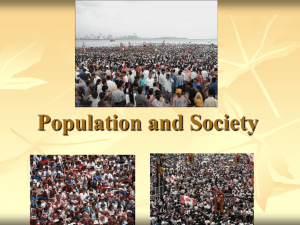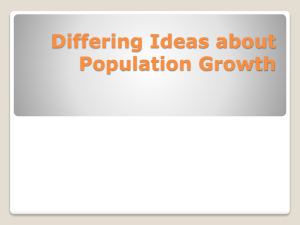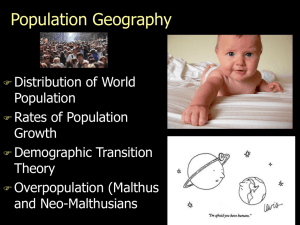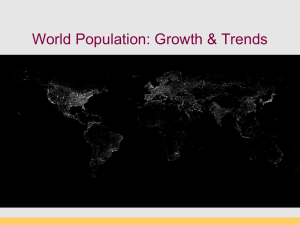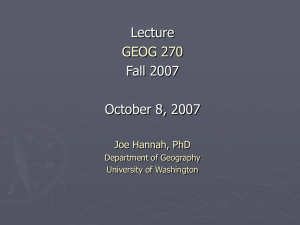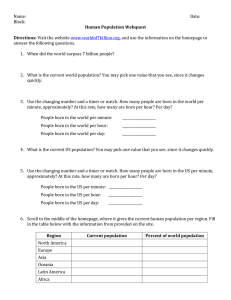Demographic Transition Theories: Population Growth Stages
advertisement
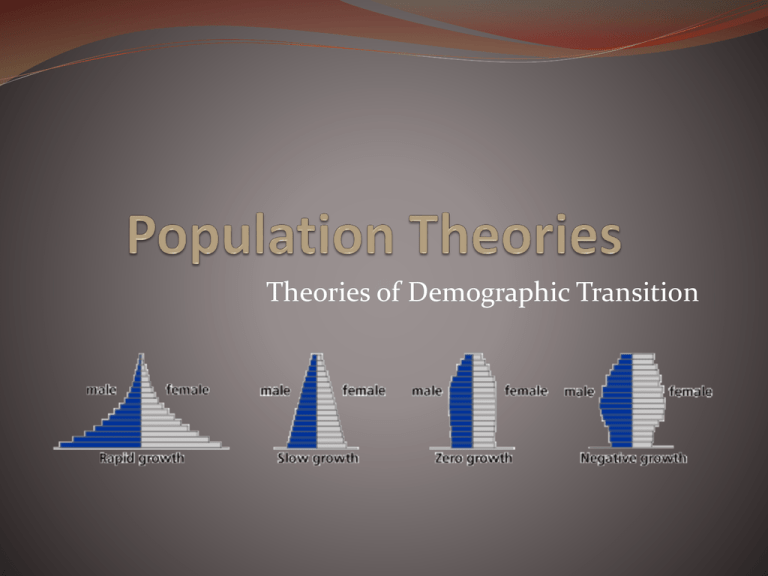
Theories of Demographic Transition Demographic Transition is the phenomenon of a country’s death and birth rates changing over time from high to low. Over time, the average family size has decreased in every country of the world. In approximately 60 countries, the total fertility rate has fallen to less than 2.1. Canada is one of these countries. Stage 1: Pre-transition Stable population High birth rate and death rate Fertility rate of 8 or more Extremely high infant mortality rate Many young children, very few older people No country in the world is still at the pretransition stage. Stage 2: Early Transition Very rapid increase in population Death rate declines rapidly Fertility rate remains high Infant mortality rate declines High birth rate Many young people Early Transition is marked by death control Stage 3: Late Transition Population growth slows down Birth rate declines rapidly Death rate declines slowly Fertility rate declines Increasing number of older people Late Transition is marked by birth control Stage 4: Post-transition Stable or slow population increase Low birth rate and death rate Fertility rate less than 2.1 Many older people which leads to a high dependency load Stage 5:? (doesn’t fit the model, but is happening now!) Declining population Extremely low birth rate Death rate is low Fertility rate less than 2 A lot of older people Is it permanent or just a temporary trend??? Optimistic vs. Pessimistic Optimistic Views Historically, large families and a growing population have been desirable for various reasons. 1. Religious Reasons: More Children = More Followers and More Followers = More Political/Social Power 2. Non-Religious Reasons: Leaders needed larger numbers to support their economic and military expansionist desires. Cornucopians Cornucopians believe that humans have the ability to find technological innovations that will increase the earth’s carrying capacity. The Agricultural and Industrial Revolutions would be their evidence. A cornucopian may say that the next major human innovation will solve our energy crisis without damaging the environment. Bogue (1960’s) D.J Bogue’s theory of demographic regulation stated that over an extended period of time, a society will naturally limit its own population in accordance to the Earth’s ability to support it. Bogue’s theory is supported by the demographic transition model and in the fact that some countries have tried to limit their population growth in recent years. Pessimistic Views Critics have all made the same basic point – Earth is of finite size and has an ability to support only a certain level of population. Thomas Malthus William Catton Warned of population Expanded on Malthus’ views problems in his writing in 1798. in 1980’s. Introduced idea of Earth’s Pop. grows in a geometric sequence (1,2,4,8,16. . .) while food grows arithmetically (1,2,3,4 . . .) carrying capacity; it can only be exceeded at the expense of the environment. Suggests we’re beyond the Only result is onset of “misery”. (famine, disease, war) carrying capacity now only because we’re using up the world’s fixed stock of natural resources for future generations.

